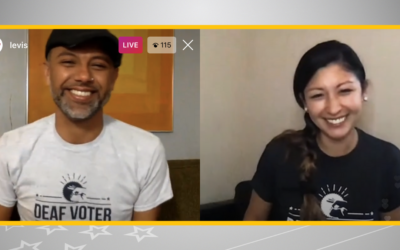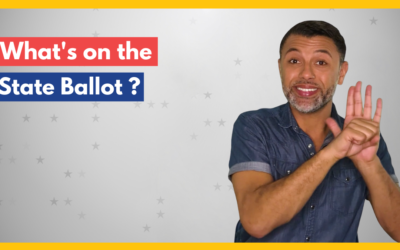Your Plan to Vote
The election isn’t on November 3rd… It’s happening right NOW! Have you voted yet? Or have you made a plan to? Thanks to the pandemic, voting is very different this year! 🗳
In the second episode of the #SignVote Series: Election 2020, learn everything you need to know about making your voting plan. Don’t let a wrong signature or lack of an umbrella or babysitter keep you from participating in the most important election of the year!
Stay tuned for the next video in our series! Until then, watch, share, and VOTE!
[TRANSCRIPT with visual descriptions: Video opens on Kriston Pumphrey, a dark tanned mid-thirties gentleman with short trimmed salt and peppered beard wearing a navy blue sweater sitting in front of a bright yellow background. Kriston’s message is in American Sign Language and accompanied by voiceover.]
With the upcoming election, I want to emphasize the importance of making a plan to vote so that you feel safe and less stressed.
[Text on screen reads: Why should you make a plan to vote. SignVote 2020. So how do you make a plan to vote? Step 1: Register your vote if you haven’t yet done so. Back to Kriston, graphics on screen accompany his message.]
Ok, first things first, register to vote! Go to www.vote.org to check or register. If you have already registered to vote, go ahead and check your registration anyway. Make sure the address and ID on file match your current address. Everything must match. If you haven’t registered and want to check the deadline, go to iwillvote.com to find out. Many states have different deadlines. They can be one or two days before the election or way earlier. So, go ahead and double-check.
[Step 2: Know what’s on your ballot]
Next, you should absolutely do an online search to find out what’s on the ballot in your state. Go to the website on the screen [vote411.org] to learn more. It’s the perfect opportunity to learn about the candidates and the various policies that will be on the ballot, and if you prefer you can also receive a sample ballot for your state too, because not all states are the same. Some may have ballot items that other states won’t. So do your research to see what’s on the ballot.
[Step 3: Choose how you’re going to vote]
Ok, moving on to the next thing you should know. It’s a little bit complicated, so it’s crucial that you remember that there is NO ONE RIGHT WAY TO VOTE. Many different factors determine how you will vote, such as where you live, your energy levels, your disability and what kinds of barriers you will face, what kind of support you have available to you…all of these things will impact your decision on how to vote. Whether you show up in person on the day of, vote early, mail in your ballot, or send in an absentee ballot. It would be best if you looked at the entire picture first to decide what works best for you. Suppose you decide to show up in person. It is important for you to show up in the right spot. Find your polling place in the link on the screen [www.vote.org.].
Once you know where to go, be sure to collect all the required documentation, such as proof of address and your ID. Make sure that you have all of these documents with you before you go. If you aren’t sure if your state requires ID, check out this website to find out. Regardless, you should bring your ID with you just to be safe. If you are going to vote in person, be prepared for bad weather, long lines, perhaps even spending all day at the polls. I don’t know. Maybe you have to try to think about being prepared for any of the following: child care to pet sitting, your work schedule, how to get to the polling center. You have to think about these things too. If your state allows early voting, that might be the best option for you. If so, do it! It might reduce some of the issues and barriers if you arrive early to vote. You’ll be less stressed and worried.
[Vote by mail-in or absentee ballot]
Ok now, let’s shift focus to mail-in and absentee ballots. You must remember two critical things – I can’t emphasize this enough: the first is the deadline to request your ballot and the deadline to return your SIGNED ballot via mail or the ballot box. You must remember both of these and set reminders in your calendar. If you’re like me and easily forget things, you MUST set reminders. It’s so important. Here’s how you can request your ballot: go to www.vote.org or go through your local elections office. Next, if you have a disability, your state is required, I repeat, required to allow you to vote with an absentee ballot or by mail. Period.
[Step 4: Vote]
Ok, so for step 4, I want to go back to what I said earlier about setting reminders. It’s that important. Especially if your mailing in your ballot or voting in person. Again, set your reminders. I suggest you set three: One week before, you vote to give yourself time to review the candidates, their policies, and all the other stuff too. Set one a few days before so you can prepare for any things that come to mind at the last minute, such as arranging care or finding directions to your polling center. Also, set a reminder on the day of so that you are in the right frame of mind to go vote when you wake up. Now during the day of, make sure you think about how much time it requires. The time of day you go can affect how much time you spend waiting in line. The weather can also be one of the many other factors in your day. Now, if you plan to work that day and are planning to show up after work, you must know – and remember this – you still have the right to vote regardless of whether the polling center is closed or not. The key is to show up in line before the doors close. If you arrived before then, they have to let you vote.
It’s time to wrap up. It’s important to remind you that the 2020 Election is happening during a really interesting period. It’s historic. Never before have we been dealing with this kind of situation. I’m talking about the pandemic and the “new normal” – well, these things on top of everything else. It’s genuinely fascinating. The most powerful thing you can do this year is to vote. The second most powerful thing, having conversations with your friends and family to make sure that they, too, are prepared to vote. If they need support, offer that support. Thank you for watching.
[Video concludes with graphics on screen reading:
Step 1: Make sure you’re registered
Step 2: Know what’s on your ballot
Step 3: Figure out how you’re going to vote. In person, early voting, mail-in or absentee ballot.
Step 4: Vote
Video ends with a credit roll. Screen fades to black. Video ends.]
[TRANSCRIPCIÓN con descripciones visuales: El video se abre con Kriston Pumphrey, un caballero bronceado de mediados de los treinta años con una barba corta y moteada y usando un suéter azul marino sentado frente a un fondo amarillo brillante. El mensaje de Kriston está en lenguaje de señas americano y está acompañado de una voz en off.]
Con las próximas elecciones, quiero enfatizar la importancia de hacer un plan para votar para que se sienta seguro y menos estresado.
[El texto en la pantalla dice: ¿Por qué deberías hacer un plan para votar? SignVote 2020. Entonces, ¿cómo se hace un plan para votar? Paso 1: registre su voto si aún no lo ha hecho. Regresando a Kriston, los gráficos en la pantalla acompañan a su mensaje.]
Ok, primero es lo primero, ¡regístrese para votar! Visite www.vote.org para verificarse o registrarse. Si ya se ha registrado para votar, siga adelante y verifique su registro de todos modos. Asegúrese de que la dirección y la identificación en el archivo coincidan con su dirección actual. Todo debe coincidir. Si aún no se ha registrado y desea verificar la fecha límite, visite www.iwillvote.com para averiguarlo. Muchos estados tienen diferentes fechas límite. Pueden ser uno o dos días antes de la elección o mucho antes. Entonces, continúe y verifique dos veces.
[Paso 2: Sepa qué hay en su boleta]
A continuación, definitivamente debe realizar una búsqueda en línea para averiguar qué hay en la boleta en su estado. Vaya al sitio web en la pantalla [vote411.org] para obtener más información. Es la oportunidad perfecta para aprender sobre los candidatos y las diversas políticas que estarán en la boleta, y si lo prefiere, también puede recibir una boleta de muestra para su estado, porque no todos los estados son iguales. Algunos pueden tener elementos de votación que otros estados no tienen. Así que investigue para ver qué hay en la boleta.
[Paso 3: elige cómo vas a votar]
Ok, pasando a lo siguiente que debes saber. Es un poco complicado, por lo que es fundamental que recuerde que NO HAY UNA FORMA CORRECTA DE VOTAR. Muchos factores diferentes determinan cómo votarás, como dónde vives, tus niveles de energía, tu discapacidad y qué tipo de barreras enfrentarás, qué tipo de apoyo tienes disponible para ti … todas estas cosas afectarán tu decisión sobre cómo votar. Ya sea que se presente en persona el día de votación, vote temprano, envíe su boleta por correo o envíe una boleta de voto ausente. Lo mejor sería que primero mirara el panorama completo para decidir qué funciona mejor para usted. Supongamos que decide presentarse en persona. Es importante que se presente en el lugar correcto. Encuentre su lugar de votación en el enlace de la pantalla [www.vote.org]..
Una vez que sepa adónde ir, asegúrese de recopilar toda la documentación requerida, como comprobante de domicilio y su identificación. Asegúrese de tener todos estos documentos con usted antes de ir. Si no está seguro de si su estado requiere una identificación, visite este sitio web para averiguarlo. Independientemente, debería traer su identificación con usted solo para estar seguro. Si va a ir a votar en persona, esté preparado para el mal tiempo, las largas filas, tal vez incluso para pasar todo el día en las urnas de votación. No lo sé. Quizás usted tenga que pensar en estar preparado para cualquiera de los siguientes escenarios: cuidado de niños hasta el cuidado de mascotas, su horario de trabajo, cómo llegar al centro de votación. También tiene que pensar en estas cosas. Si su estado permite la votación anticipada, esa podría ser la mejor opción para usted. Si es así, ¡hazlo! Podría reducir algunos de los problemas y barreras si usted llega temprano para votar. Estará menos estresado y preocupado.
[Voto por correo o en ausencia]
Bien, cambiemos el enfoque a las boletas de votación por correo y en ausencia. Usted debe recordar dos cosas fundamentales – no puedo enfatizar esto lo suficiente: la primera es la fecha límite para solicitar su boleta y la fecha límite para devolver su boleta FIRMADA por correo o en las urnas de votación. Debe recordar ambos y establecer recordatorios en su calendario. Si eres como yo y olvidas las cosas fácilmente, DEBES establecer recordatorios. Es tan importante. Acá, le indicamos cómo puede solicitar su boleta: visite www.vote.org o visite la oficina electoral local. A continuación, si tiene una discapacidad, se requiere que su estado, repito, le permita votar con una boleta de voto ausente o por correo. Punto.
[Paso 4: votar]
Bien, para el paso 4, quiero volver a lo que dije antes sobre la configuración de recordatorios. Es tan importante. Especialmente si envía su boleta por correo o vota en persona. Una vez más, configure sus recordatorios. Le sugiero que establezca tres: una semana antes, vote para darse tiempo para revisar a los candidatos, sus políticas y, todo lo demás también. Establezca un recordatorio unos días antes para que pueda prepararse para cualquier cosa que le venga a la mente en el último minuto, como organizar la atención o encontrar direcciones para su centro de votación. Además, establezca un recordatorio para el mismo día de votación para que esté en el estado de ánimo adecuado para ir a votar cuando se despierte. Ahora, durante el día de, asegúrese de pensar cuánto tiempo requiere. La hora del día a la que vaya puede afectar la cantidad de tiempo que pasa esperando en la fila. El clima también puede ser uno de los muchos otros factores de su día. Ahora bien, si planea trabajar ese día y planea presentarse después del trabajo, debe saber, y recordar esto, usted aún tiene derecho a votar independientemente de si el centro de votación está cerrado o no. La clave es llegar a hacer fila antes de que se cierren las puertas. Si llegaste antes, entonces tienen que dejarte votar.
Es hora de terminar. Es importante recordarle que las elecciones del 2020 se están celebrando durante un período realmente interesante. Es histórico. Nunca antes nos habíamos enfrentado a este tipo de situaciones. Me refiero a la pandemia y la “nueva normalidad” – bueno, estas cosas además de todo lo demás. Es realmente fascinante. Lo más poderoso que puedes hacer este año es votar. La segunda cosa más poderosa es tener conversaciones con sus amigos y familiares para asegurarse de que ellos también estén preparados para votar. Si necesitan apoyo, ofrézcales ese apoyo. Gracias por ver.
[El video concluye con gráficos en la lectura de la pantalla:
Paso 1: asegúrese de estar registrado
Paso 2: Sepa lo que hay en su boleta
Paso 3: averigua cómo vas a votar. En persona, votación anticipada, por correo o en ausencia.
Paso 4: votar
El video termina con una lista de créditos. La pantalla se vuelve negra. El video termina.]




